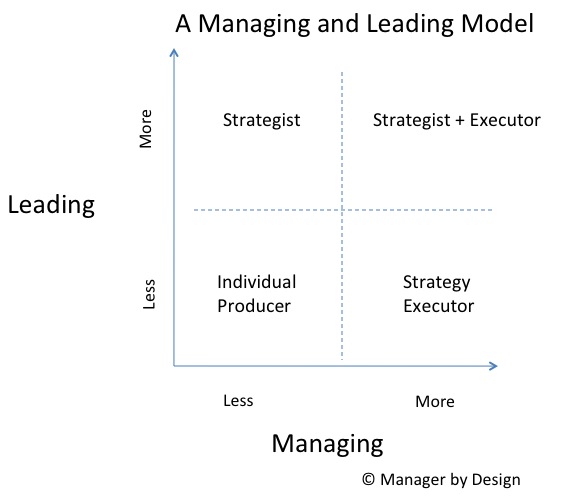Management Design: The designs we have now – Manager knows and supports only one possible strategy
In my previous article, I showed a model I created that identifies the difference between being a leader and a manager. Here it is:
In this model, the manager that I typically think of when writing about managers is in the lower right corner – a manager who is a “Strategy Executor.” The organization that the manager works for has a strategy, and the manager makes sure that this strategy is executed. This manager typically has a team of people in some capacity (either direct reports, virtual, outsourced vendor) to make sure the strategy is executed.
As an example, if you are a Training Manager, then the strategy is that the organization is using “Training” as a means to help the organization run better. “Training” is the Strategy, and the Training Manager is needed to execute that strategy.
So the training manager has to make sure the training is executed. That means there needs to be budget, a team of people and facilities to get this done somehow. That’s the manager’s job – use these resources to execute the “Training” Strategy.
But how does one become a strategy executor, a.k.a., manager? There are various paths.
The most commonly thought of path is the following:
- Someone is really good at being an individual producer, and the manager role opens up, and they get the job as the manager. That individual producer is now the strategy executor. Here’s how it looks on the model:
This seems to fit in the popular conception of how people become managers, but under this model, you can see a potential design flaw. The person becomes a manager without having been involved with the strategy development. In the case of the Training Manager, the strategy executor will be executing the “Training Strategy” without really knowing what went into the development of that strategy.
So there are few issues with this:
2. The Strategy Executor (manager) never learned the method for developing a strategy for the organization, and this is a key leadership action (and, in my model, the key leadership action)
What this means is that the manager never went through the path of becoming a strategist, and demonstrating the requisite leadership in doing so. As a result, the manager will not see the strategy as a) something that can change and b) as something of value. The manager will likely see the strategy as something as eternal, inevitable, and unchanging.
2. The Strategy Executor (manager) will be resistant to change, rather than seek change.
So if your organization wants to change the strategy, the manager will be a key point of resistance to the strategy. The manager will see the strategy as the only possible strategy, given that they have had, in this model, two jobs making sure that strategy is implemented.
As an example, in the Training Manager example, let’s say the strategy changes – the Training Department is no longer doing Training but is now “Performance Consulting.” The Training Manager will be highly resistant to this, because the momentum, role and understanding of what Training is has been confirmed, and there was never a time where the Training Manager was in the strategist role and could explore the larger possibilities for the organization.
So under this model, you can see that when you promote an individual producer to the manager role, you are further solidifying your legacy strategy, and making it more difficult to change the strategy in the future. On top of that, you have the inevitable difficulties of making the transition to being a manager from individual contributor. At least with this model you can focus on these challenges, and the manager can focus entirely on being a better manager, so it isn’t an entirely bad design.
As such, this may be a design choice for many organizations, but for others, this is a design flaw. It creates managers who do not think strategically, and it makes changing an organization’s path much more difficult. So if you are trying to institute a change, you need to look at this design and see that you may have designed in change resistance at the managerial level.
In the emerging field of management design, I advocate understanding what designs can be employed so that managers can execute a strategy – both new and existing. Under the current design, many managers are set up for executing only the existing strategy, and if that changes, the organization is in trouble.
Related articles:
A model to show the difference between managing and leading
Are you asking a change agent to make a change, and then resisting the change?
What to do when someone on your team resists change (part 1)
What to do when someone on your team resists change (part 2)

